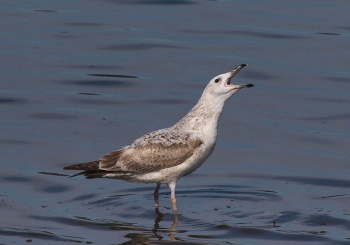- Larus cachinnans
Formerly included Steppe Gull
Identification
A four-year gull. Slenderer and with a smaller head than European Herring Gull. Has a slender, parallel-edged bill and small eyes sitting well forward in head. The neck is long, the breast well protruding and the hindparts slender. Often shows a pronounced hanging-belly behind the long, thin legs.
Adult
Has a similar wing pattern to European Herring Gull: White tip to P10, but white tongues on primaries long and often creating a streaked wing-tip. P5 with extensive black markings. The head is white, sometimes with some faint brown hindneck-streaks in autumn. The eye is often darkish-looking, the bill often greenish-tinged. The legs are grey with fleshy to yellow tinge.
Third-year
Like adult but with generally fuller black on wing-tip and often dark markings on primary coverts, tail and bill.
Second-year
Grey upperparts contrast with browner lesser and greater coverts, has a solid dark wing-tip (sometimes with white mirror on P10) and whitish head, underbody and underwing. May show traces of a dark tail-bar.
First-year
White on head and body reduced to spots on hindneck, some faint spots on breast-sides, flangs and edges of undertail-coverts. Bill and eye black. Upperwing brown with solid dark bars across bases of secondaries and greater coverts (like Lesser Black-backed Gull). Tertials dark with white tips. Shows a pale wedge on lower back, reaching the white tail-base which contrasts with the solid blackish tail-bar. Underwing often mainly white.
Similar species
May be confused with Yellow-legged Gull, European Herring Gull, Lesser Black-backed Gull and other big gulls. Somewhat similar to Common Gull / Short-billed Gull: this is smaller with a plain bill, darker mantle and larger white wing tips.
Distribution
Black Sea to Caspian Sea, S & E Kazakhstan and W China (W Xinjiang), and expanding westward in Europe where breeding regularly in Poland from 1980s, Saxony and recently found nesting in the Netherlands. Winters S to SW Asia, Middle East and NE Africa and increasingly in C & W Europe.
Taxonomy
This species is sometimes considered conspecific with Yellow-legged Gull, with both also formerly included as subspecies within a more inclusive version of Herring Gull. Its westwards range expansion has brought it into contact with European Herring Gulls in central and northern Poland, with many records of hybrid pairs in this area[1][2]. Former subspecies L. c. barabensis breeding in the steppes of central Asia, wintering in southwest Asia and western India - Steppe Gull (sometimes regarded as full species) is now considered to be a race of Lesser Black-backed Gull. Former subspecies L. c. mongolicus from the Altai and Lake Baikal to Mongolia, wintering in eastern Asia from Japan south through eastern and southern China to northernmost Vietnam - Mongolian Gull (formerly regarded as a subspecies of the expanded Herring Gull).
Subspecies
This is a monotypic species[3].
Habitat
Breeds on sandy dunes, islands, steppe lakes and along rivers. Recently colonising post-industrial wetlands such as old sand and gravel quarry lakes in eastern and central Europe.
Outside breeding season at coasts, in harbours, on lakes or on rubbish dumps.
Behaviour
They are scavengers and hunt suitable small prey in fields or on the coast, or rob plovers or lapwings of their catches.
References
- Gibbins, C, Small, B. J., & Sweeney, J. (2010). Identification of Caspian Gull, part I. British Birds 103: 142-183.
- Gibbins, C, Neubauer, G., & Small, B. J. (2011). Identification of Caspian Gull, part II. British Birds 104: 702-742.
- Clements, J. F., P. C. Rasmussen, T. S. Schulenberg, M. J. Iliff, T. A. Fredericks, J. A. Gerbracht, D. Lepage, A. Spencer, S. M. Billerman, B. L. Sullivan, M. Smith, and C. L. Wood. 2024. The eBird/Clements checklist of Birds of the World: v2024. Downloaded from https://www.birds.cornell.edu/clementschecklist/download/
- Gill, F, D Donsker, and P Rasmussen (Eds). 2024. IOC World Bird List (v 14.2). Doi 10.14344/IOC.ML.14.2. http://www.worldbirdnames.org/
- Dickinson, EC, ed. 2003. The Howard and Moore Complete Checklist of the Birds of the World. 3rd ed., with updates to December 2007 (Corrigenda 7). Princeton: Princeton Univ. Press. ISBN 978-0691117010
- Sibley, CG and BL Monroe. 1996. Birds of the World, on diskette, Windows version 2.0. Charles G. Sibley, Santa Rosa, CA, USA.
- Malling Olsen K and H Larsson. 2003. Gulls of Europe, Asia and North America. London: Christoper Helm. ISBN 0 7136 7087 8
- Neubauer, G., Faber, M. & Zagalska-Neubauer, M. (2010) Yellow-legged Gull in Poland: status and separation from yellow-legged Herring Gull and hybrids. Dutch Birding 32(3): 163–170.
- ID discussion on how to distinguish Caspian (L. cachinnans) and Yellow-legged Gull (L. michahellis and L. m. atlantis)
Recommended Citation
- BirdForum Opus contributors. (2025) Caspian Gull. In: BirdForum, the forum for wild birds and birding. Retrieved 11 May 2025 from https://www.birdforum.net/opus/Caspian_Gull
External Links
GSearch checked for 2020 platform.1





